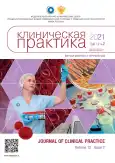Clinical case of Guillain-Barré syndrome associated with COVID-19
- Authors: Shirshova E.V.1, Knaub V.V.2, Baklaushev V.P.3
-
Affiliations:
- Federal Research and Clinical Center of Specialized Medical Care and Medical Technologies
- Federal Clinical and Research Center for Specialized Medical Care and Medical Technologies of the Federal Medical Biological Agency
- Federal Research and Clinical Center of Specialized Medical Care and Medical Technologies FMBA of Russia
- Issue: Vol 12, No 2 (2021)
- Pages: 110-118
- Section: Case reports
- URL: https://journals.rcsi.science/clinpractice/article/view/72264
- DOI: https://doi.org/10.17816/clinpract72264
- ID: 72264
Cite item
Abstract
Background: The coronavirus infection caused by SARS-Cov-2 is characterized by a damage to many organs and systems of the human body. To date, convincing information has been obtained about the involvement of various parts of the nervous system in the pathological process in patients with COVID-19. Among the most frequently described impairments, there are disorders of smell and taste, common disorders of the central nervous system, characterized by general cerebral symptoms, such as headache, asthenization, psychopathological disorders. One of the rare and severe forms of the peripheral nervous system damage in COVID-19 is Guillain-Barre syndrome (GBS), characterized by acute post-infectious inflammatory polyneuropathy with an autoimmune etiology. Clinical case description. We present a clinical case of GBS associated with COVID-19. The disease debuted as a peripheral tetraparesis with a progredient course of up to 21 days. Systemic administration of immunoglobulin stopped the disease progression. The association of GBS with COVID-19 was clarified a month after the disease onset, when bilateral polysegmental pneumonia was diagnosed, and a high level of IgG to the S-protein of SARS-CoV-2 was found, 3 times higher than the level of IgM, which indicated the duration of the disease was not less than three weeks. Conclusion: The GBS development upon infection with SARS-CoV-2 may precede the lung damage. The debut of GBS during the COVID-19 pandemic requires the exclusion of the SARS-CoV-2 etiological role in each case.
Full Text
##article.viewOnOriginalSite##About the authors
Elena V. Shirshova
Federal Research and Clinical Center of Specialized Medical Care and Medical Technologies
Author for correspondence.
Email: shirshova.ev@fnkc-fmba.ru
ORCID iD: 0000-0001-9193-0534
SPIN-code: 7491-0434
MD, Dr. Sci. (Med.)
Russian Federation, 28, Orekhovy blvd, Moscow, 115682Vladimir V. Knaub
Federal Clinical and Research Center for Specialized Medical Care and Medical Technologies of the Federal Medical Biological Agency
Email: knaub.vladimir.v@gmail.com
ORCID iD: 0000-0002-1688-3923
Neurologist
Russian Federation, 28, Orekhovy blvd, Moscow, 115682Vladimir P. Baklaushev
Federal Research and Clinical Center of Specialized Medical Care and Medical Technologies FMBA of Russia
Email: baklaushev.vp@fnkc-fmba.ru
ORCID iD: 0000-0003-1039-4245
SPIN-code: 3968-2971
Dr. Sci. (Med.)
Russian Federation, 28 Orekhovy boulevard, Moscow, 115682References
- Vestergaard LS, Nielsen J, Richter L et al.; ECDC Public Health Emergency Team for COVID-19, Krause TG, Mølbak K. Excess all-cause mortality during the COVID-19 pandemic in Europe — preliminary pooled estimates from the EuroMOMO network, March to April 2020. Euro Surveill. 2020;25(26):2001214. doi: 10.2807/1560-7917.ES.2020.25.26.2001214
- Baklaushev VP, Kulemzin SV, Gorchakov АА, et al. COVID-19. Etiology, pathogenesis, diagnosis and treatment. Journal of Clinical Practice. 2020;11(1):7–20. (In Russ). doi: 10.17816/clinpract26339
- Zabozlaev FG, Kravchenko EV, Gallyamova AR, Letunovskiy NN. Pulmonary pathology of the new coronavirus disease (Covid-19). The preliminary analysis of post-mortem findings. Journal of Clinical Practice. 2020;11(2):21–37. doi: 10.17816/clinpract34849
- Klypa TV, Bychinin MV, Mandel IA, et al. Clinical characteristics of patients admitted to an ICU with COVID-19. predictors of the severe disease. Journal of Clinical Practice. 2020;11(2):6–20. doi: 10.17816/clinpract34182
- Belopasov VV, Yachou Y, Samoilova EM, Baklaushev VP. The nervous system damage in COVID-19. Journal of Clinical Practice. 2020;11(2). doi: 10.17816/clinpract34851
- Камчатов П.Р., Евзельман М.А., Чугунов А.В. Поражение периферической нервной системы при коронавирусной инфекции COVID-19 // РМЖ. 2021. № 5. С. 30–31. [Kamchatov PR, Evzelman MA, Chugunov AV. Lesion of the peripheral nervous system in coronavirus infection COVID-19. RMJ. 2021;(5):30–31. (In Russ).]
- Cantuti-Castelvetri L, Ojha R, Pedro LD, et al. Neuropilin-1 facilitates SARS-CoV-2 cell entry and infectivity. Science. 2020;370(6518):56–86. doi: 10.1126/ science. abd2985
- Fragiel M, Miró Ò, Llorens P, et al. Incidence, clinical, risk factors and outcomes of Guillain-Barré in Covid-19. Ann Neurol. 2020. doi: 10.1002/ana.25987
- Rinaldi S. Coronavirus Disease 2019 and the risk of Guillain-Barré syndrome. Ann Neurol. 2021;89(4):846. doi: 10.1002/ana.26011
- Hasan I, Saif-Ur-Rahman KM, Hayat S, et al. Guillain-Barré syndrome associated with SARS-CoV-2 infection: a systematic review and individual participant data metaanalysis. J Peripher Nerv Syst. 2020;25:335–343.
- Toscano G, Palmerini F, Ravaglia S, et al. Guillain-Barré syndrome associated with SARS-CoV-2. N Engl J Med. 2020;382(26):2574–2576. doi: 10.1056/NEJMc2009191
- Keddie S, Pakpoor J, Mousele C, et al. Epidemiological and cohort study finds no association between COVID-19 and Guillain-Barré syndrome. Brain. 2020;awaa433. doi: 10.1093/brain/awaa433
- Leonhard SE, Mandarakas MR, Gondim FA, et al. Diagnosis and management of Guillain-Barre syndrome in ten steps. Nat Rev Neurol. 2019;15(11):671–683. doi: 10.1038/s41582-019-0250-9
- Левин О.С. Полинейропатии. Москва: Мед. информ. агентство, 2011. С. 49–97. [Levin OS. Polyneuropathy. Moscow: Med. inform. Agency; 2011. Р. 49-97. (In Russ).]
- Гришина Д.А., Супонева Н.А., Пирадов М.А., и др. Электрофизиологические критерии прогноза при синдроме Гийена–Барре // Нервно-мышечные болезни. 2012. № 3. С. 33. [Grishina DA, Suponeva NA, Piradov MA, et al. Electrophysiological prognosis criteria for Guillain-Barre syndrome. Neuromuscular Diseases. 2012;(3):33. (In Russ).]
- Пирадов М.А., Супонева Н.А. Синдром Гийена–Барре: диагностика и лечение. Москва: Мед. информ. агентство, 2011. С. 10–37. [Piradov MA, Suponeva NA. Guillain-Barre syndrome: diagnosis and treatment. Moscow: Med. inform. agency, 2011. Р. 10–37. (In Russ).]
- Zhao H, Shen D, Zhou H, et al. Guillain-Barré syndrome associated with SARS-CoV-2 infection: causality or coincidence? Lancet Neurol. 2020;19(5):383–384. doi: 10.1016/S1474-4422(20)30109-5
- Gutiérrez-Ortiz C, Méndez A, Rodrigo-Rey S, et al. Miller-Fisher syndrome and polyneuritis Cranialis in COVID-19. Neurology. 2020;10.1212/WNL.0000000000009619. doi: 10.1212/WNL.0000000000009619
- Caress JB, Castoro RJ, Simmons Z, et al. COVID-19-associated Guillain-Barré syndrome: The early pandemic experience. Muscle Nerve. 2020;62(4):485-491. doi: 10.1002/mus.27024
- Malek E, Salameh J. Guillain-Barre syndrome. Semin Neurol. 2019;39:589–595. doi: 10.1055/s-0039-1693005
- Willison HJ, Jacobs BC, van Doorn PA. Guillain-Barré syndrome. Lancet. 2016;388(10045):717–727. doi: 10.1016/S0140-6736(16)00339-1
- Caress JB, Castoro RJ, Simmons Z, et al. COVID-19-associated Guillain-Barre syndrome: the early pandemic experience. Muscle Nerve. 2020;62(4):485–491. doi: 10.1002/mus.27024.
Supplementary files








